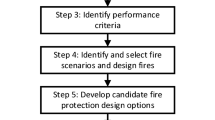Abstract
The United States alone spends $700 billion a year on new and renovated construction. About 20% of this money assures safety from unwanted fires, and this portion includes the cost of insurance to families and businesses. This enormous cost could be reduced by introducing fire safe products to the building and transportation industries, both in the United States and abroad, and by introducing advanced detectors, suppression systems, and firefighting equipment to the fire protection industry. In order to show that these products and mechanisms are safe to use, industries need performance measures. Performance-based fire standards are currently being developed to augment prescriptive standards around the world.
Performance-based standards are intended to provide flexibility in maintaining accepted fire safety levels among competitive products, while ensuring life safety and reducing property loss. At the same time, performance-based requirements should reduce design and construction costs, as well as the cost of maintenance and liability coverage. In order to derive these benefits, evaluation tools are needed. One such tool, HAZARD I, helps users understand the consequences of unwanted fires by making the results of recent fire research available to them. Improvements to the program will include increased applicability, improved usability, the ability to address additional building features, and more accurate treatment of fire behavior and its effects on people and their actions. Many of the improvements made already in the software documentation are based on the experience of fire protection engineers and others who have used the program. User input, combined with other planned program improvements, constitute the first step in the overall goal of a complete Fire Hazard assessment methodology.
Similar content being viewed by others
References
Bukowski, R. W., Peacock, R. D., Jones, W. W. and Forney, C. L., “Fire Hazard Assessment Method,” NIST Handbook 146, Volumes I, II, and III, National Institute for Standards and Technology, Gaithersburgh, Maryland (1989).
Cooper, L. Y., Fire-Plume Generated Ceiling Jet Characteristics and Convective Heat Transfer to Ceiling and Wall Surfaces in a Two-Layer Zone-Type Fire Environment: Uniform Temperature Ceiling and Walls, National Institute of Standards and Technology Internal Report 4705 (1991).
Forney, G. P., Computing Radiative Heat Transfer Occurring in a Zone Fire Model, National Institute of Standards and Technology (USA) Internal Report 4709 (1992).
Hoover, J. H., Validation of Gas Phase Absorbance Algorithm in the Consolidated Fire Growth and Smoke Transport Model (CFAST), Naval Research Laboratory Letter Report 6180/0020A (1996).
Snell, J. E., Levin, B. C., and Fowell, A. J., Workshop on Combustion Product Toxicology, Summary of Presentations, September 10, 1982, U.S. National Bureau of Standards, NBSIR 82-2634 (1982).
Snell, J. E., “Hazard Assessment: Challenge to Fire Science,” Journal of Fire Science, Volume 1,No. 4 (1983).
Lyons, J. W., Statement of Dr. John W. Lyons before the Senate Committee on Labor and Human Resources, Hearing on Fire Safety Issues, July 19, 1983.
Bukowski, R. B., Peacock, R. D., Jones, W. W. and Forney, C. L., “Technical Reference Guide for the HAZARD I Fire Hazard Assessment Method,” NIST Handbook 146, Volume I, National Institute for Standards Technology, Gaithersburgh, Maryland (1989).
Bukowski, R. B., Peacock, R. D., Jones, W. W., and Forney, C. L., “Example Cases for the HAZARD I Fire Hazard Assessment Method,” NIST Handbook 146, Volume III, National Institute for Standards Technology, Gaithersburgh, Maryland (1989).
Jones, W. W. and Peacock, R. D., “Refinement and Experimental Verification of a Model for Fire Growth and Smoke Transport,” paper presented at the Second Annual Symposium on Fire Safety Science, Tokyo, Japan (June 1988).
Portier, R., “A Programmer's Reference Guide to FDMS File Formats,” NIST Internal Report 5162 (1993).
Portier, R., Fire Data Management System, FDMS 2.0, Technical Documentation, National Institute of Standards and Technology Technical Note 1407 (1994).
McCaffrey, B. J., “Momentum Implications for Buoyant Diffusion Flames,” Combustion Science and Technology, Volume 52,Number 149 (1983).
Jones, W. W., “Refinement of a Model for Fire Growth and Smoke Transport,” NIST Technical Note 1282, 1990.
Author information
Authors and Affiliations
Rights and permissions
About this article
Cite this article
Jones, W.W. The Evolution of HAZARD, the Fire Hazard Assessment Methodology. Fire Technology 33, 167–182 (1997). https://doi.org/10.1023/A:1015399118241
Issue Date:
DOI: https://doi.org/10.1023/A:1015399118241




